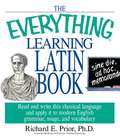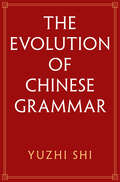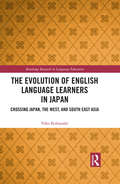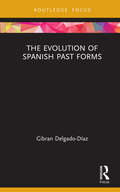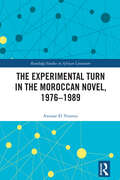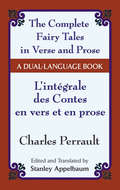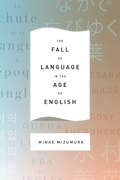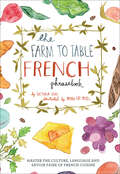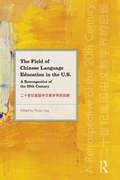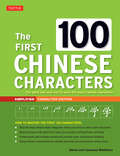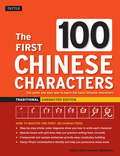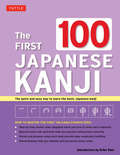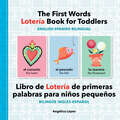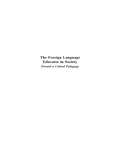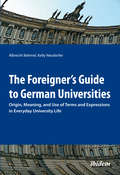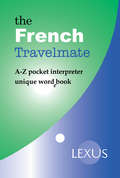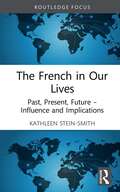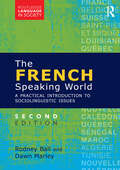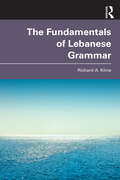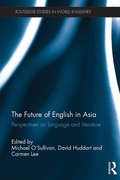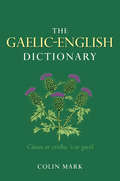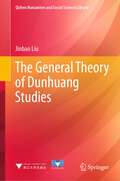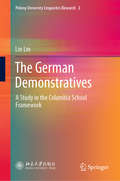- Table View
- List View
The Everything® Learning Latin book
by Richard E. PriorLatin is a living, breathing language! Many of the English words you use today, such as ad hoc, memorandum, et cetera, and habitat, are based on Latin roots. A basic understanding of Latin will vastly improve your English vocabulary and provide keys to understanding legal, medical, and scientific nomenclature. The Everything? Learning LatinBook builds upon what you already know about English to teach you the basics of Latin grammar, usage, and vocabulary. Through step-by-step instruction, practical exercises, and cultural information,The Everything? Learning Latin Bookwill have you speaking like a Roman in no time. Other features include: The history and evolution of the Latin language Extensive glossaries Exercises Pronunciation instruction
The Evolution of Chinese Grammar
by Yuzhi ShiThe Chinese language has the longest well-documented history among all human languages, making it an invaluable resource for studying how languages develop and change through time. Based on a twenty-year long research project, this pioneering book is the English version of an award-winning study originally published in Chinese. It provides an evolutionary perspective on the history of Chinese grammar, tracing its development from its thirteenth-Century BC origins to the present day. It investigates all the major changes in the history of the language within contemporary linguistic frameworks, and illustrates these with a wide range of examples taken from every stage in the language's development, showing how the author's findings are relevant to contemporary descriptive, theoretical, and historical linguistics. Shedding light on the essential properties of Chinese and, ultimately, language in general, it is essential reading for academic researchers and students of Asian linguistics, historical linguistics and syntactic theory.
The Evolution of English Language Learners in Japan: Crossing Japan, the West, and South East Asia (Routledge Research in Language Education)
by Yoko KobayashiThis book seeks a better understanding of the sociocultural and ideological factors that influence English study in Japan and study-abroad contexts such as university-bound high schools, female-dominant English classes at college, ESL schools in Canada, and private or university-affiliated ESL programs in Singapore and Malaysia. The discussion is based not only on data garnered from Japanese EFL learners and Japanese/overseas educators but also on official English language policies and commercial magazine discourses about English study for Japanese people. The book addresses seemingly incompatible themes that are either entrenched in or beyond Japan’s EFL context such as: Japan’s decades-long poorly-performing English education vs. its equally long-lived status as an economic power; Japanese English learners’ preference for native English speakers/norms in at-home Japanese EFL contexts vs. their friendship with other Asian students in western study-abroad contexts; Japanese female students’ dream of using English to further their careers vs. Japanese working women’s English study for self-enrichment; Japanese society’s obsession with globalization through English study vs. the Japanese economy sustained by monolingual Japanese businessmen; Japanese business magazines’ frequent cover issues on global business English study vs. Japanese working women’s magazines’ less frequent and markedly feminized discourses about English study.
The Evolution of Spanish Past Forms (Routledge Studies in Hispanic and Lusophone Linguistics)
by Gibran Delgado-DíazThe Evolution of Spanish Past Forms examines how Spanish past forms have changed diachronically. With examples from Medieval Spanish, Golden Age Spanish, and Modern Spanish literary works, this book demonstrates how language is dynamic and susceptible to change. The past forms considered here include the preterit, the imperfect, the imperfect progressive with estar (temporal to be), the present perfect, the imperfect progressive with other auxiliary verbs, the preterit progressive with estar, and the preterit progressive with other auxiliary verbs. This book will be of interest to scholars and graduate students investigating tense and aspect phenomena in Spanish and other languages, grammaticalization processes, and language variation and change.
The Experimental Turn in the Moroccan Novel, 1976-1989 (Routledge Studies in African Literature)
by Anouar El YounssiThe Experimental Turn in the Moroccan Novel, 1976-1989 examines the trajectory of the Moroccan experimental novel and makes a link between its emergence in the early-mid 1970s and the Arab defeat in the six-day war with Israel in 1967.Drawing on works by Muḥammad Barrādah, ʿAbdullāh al-ʿArwī, Aḥmad al-Madīnī, and others, the book contends that the Moroccan experimental novel reflects an historic turning point and transitional cultural landscape. It further shows that the experimental novel laid the ground for a different vision of literature, an important feature of which was the intent to surpass the traditional realist model as executed by Moroccan novelist ʿAbdulkarīm Ghallāb (1919–2017) and Egyptian Nobel laureate Najīb Maḥfūẓ (1911–2006). This new vision of literature seeks to create new discursive spheres for the treatment of the social and the political.This book will be an important contribution to debates around Moroccan/Arabic/Maghrebi literature, as well as to the field of literary experimentalism more broadly.
The Fairy Tales in Verse and Prose/Les contes en vers et en prose: A Dual-Language Book
by Charles Perrault Stanley AppelbaumBased on the folkloric tales told by the widowed author to his motherless brood, this collection of traditional stories first appeared under Charles Perrault's name in the 18th century. In the fine tradition of Aesop, the fables enlighten as well as entertain, imparting practical moral advice. This dual-language edition features accurate new English translations on the pages facing the original French, in addition to an informative introduction and annotations. It opens with a trio of tales in verse: "Grisélidis," the legend of a patient wife, derived from Boccaccio's Decameron; "Peau d'Ane" ("Donkey-Skin"), the story of a beauty in disguise; and a familiar farce known as "Les souhaits ridicules" ("The Ludicrous Wishes"). Well-known and much-loved prose tales follow: "Sleeping Beauty," "Little Red Riding Hood," "Puss in Boots," "Cinderella," and others. This is the most complete edition available in English, comprising the verse tales as well as those in prose, plus all the original prefaces, letters, introductions, morals, and more. Any student of French language or literature will welcome this comprehensive edition.
The Fall of Language in the Age of English
by Juliet Winters Carpenter Minae Mizumura translated by Mari YoshiharaMinae Mizumura was born in Tokyo, moved to New York at the age of twelve, and studied French literature at Yale University. Acclaimed for her audacious experimentation and skillful storytelling, Mizumura has won major literary awards for all four of her novels--one of which, A True Novel, recently was published in English. She lives in Tokyo.
The Farm to Table French Phrasebook: Master the Culture, Language and Savoir Faire of French Cuisine
by Victoria MasFrench culinary phrases, foodie terms, and cultural tips come together in the ultimate food-lover&’s guide pays des délices. Everyone can tell the difference between Brie and Caembert, but few know their Valençay from Pélardon. Luckily, The Farm to Table French Phrasebook serves up the vital French expressions other guides leave off the plate. From the specialty vocabulary of chefs in gourmet restaurants to slang terms rarely heard outside a country market, here&’s everything the reader needs for a gourmet tour of France (or the local bistro!). A comprehensive language guide for food lovers, this indispensable companion also offers a fascinating history of French eats, complete with delicious facts about the cuisines of every region from Alsace&’s pinot gris to Normandy&’s Pot-au-feu. This beautifully illustrated book is perfect to take along for a day of sampling gourmet local specialties, or it makes a great present for the Francophile in your life.The Farm to Table French Phrasebook opens a bountiful world of food that you won&’t find in any textbook or classroom:• Navigate produce markets, charcuteries and patisseries• Prepare meals the French way with delicious, authentic recipes• Speak the lingo of Paris&’s top restaurants and bistros• Pair regional wines with delightful cheeses• Master the proper table etiquette for dining at a friend&’s house
The Field of Chinese Language Education in the U.S.: A Retrospective of the 20th Century
by Vivian LingThis book will be the first account of the development of Chinese as a foreign language in the U.S., as it interacts with the relevant entities in China and beyond. There are virtually no systematic retrospective reflections on the field outside of the greater China region; and yet over the past decades the field has grown by leaps and bounds, and it is critical now that we pause to reflect on what has happened and what we can learn from the past. The contributors are among some of the most influential pioneers in the field whose entire academic lives have been dedicated to its development. The Field of Chinese Language Education in the U.S.: A Retrospective of the 20th Century is aimed at those who are currently engaged in Chinese language education, as teachers or as students.
The First 100 Chinese Characters: Simplified Character Edition
by Alison Matthews Laurence MatthewsThis book is a quick and easy way to learn basic Chinese Characters.All beginning students of Chinese struggle to memorize and learn to write the Chinese characters. The First 100 Chinese Characters adopts a structural approach which helps students to quickly master the basic characters that are fundamental to this language.The English meanings, pronunciations in hanyu pinyin and alternate forms (if any) for each Chinese character are presented along with a stroke order guide and spaces for writing practice. Printed with gray guidelines, the stroke order guides are designed to be traced over to teach students the standard sequence of strokes used to write the character. Related compounds and phrases are given to assist in vocabulary building. Three indexes at the back allow the characters to be looked-up by their English meanings, hanyu pinyin pronunciations, or radicals. Extra practice sheets are also provided.This book contains: Step-by-step stroke order diagrams show you how to write each character. Special boxes with grid lines help you practice writing them correctly. Compounds and sample sentences provide easy vocabulary building. Hanyu pinyin romanizations identify and help you pronounce every word.
The First 100 Chinese Characters: Traditional Character Edition
by Alison Matthews Laurence MatthewsThis book is a quick and easy way to learn the first 100 basic Chinese traditional characters.For effective leaning, memorization and practice, each Chinese character is shown separately on a single page, together with its English definitions, hanyu pinyin romanization, alternate form (if any), a stroke order guide and ample space for writing practice. Printed in gray lines, the stroke order guides introduce the student to the standard stroke sequence used in writing the characters, by tracing over them. After learning the correct stroke order, the student can then practice writing the character on their own, thus reinforcing recognition and memorization. Large boxes with grids for correct proportions are provided. Related compounds and phrases containing each character are also included to assist in vocabulary building. Three indexes (alphabetically by the English meanings and the pinyin romanization, and by radicals) are provided at the back of the book for quick and esy reference, along with extra sheets of blank boxes for writing practice. Featured are:The 100 most frequently-used Chinese charactersFoundation characters for the HSK A level language proficiency testStandard hanyu pinyin romanizationsStep-by-step stroke order guides and ample space for writing practiceOver 500 words and phrases containing the basic charactersConcise English definitions
The First 100 Japanese Kanji
by Eriko SatoThis is an invaluable study guide for learning basic Japanese characters.The first 100 Japanese Kanji is intended for beginning students, or experienced speakers who need to practice their written Japanese. Kanji are an essential part of the Japanese language and together with kana (hiragana and katakana) comprise the written component of Japanese.This book presents the kanji characters that are most commonly used. They have been carefully selected for rapid and effective learning. Each kanji's readings, meanings, and common compounds are presented, and romanized pronunciations for English speakers (romanji) are included as well. Printed with gray guidelines, stroke order guides are designed to be traced over to teach students the standard sequence of strokes used to write each character. Three indexes at the back allow the characters to be looked up as with a dictionary or by their readings. Students who wish to practice writing kanji will find extra practice sheets available.This book includes:Step-by-step stroke order diagrams for each characterSpecial boxes with grid lines to practice writing charactersWords and phrases using each kanjiRomanizations (romanji) to help identify and pronounce every word
The First 100 Japanese Kanji
by Eriko SatoThis is an invaluable study guide for learning basic Japanese characters.The first 100 Japanese Kanji is intended for beginning students, or experienced speakers who need to practice their written Japanese. Kanji are an essential part of the Japanese language and together with kana (hiragana and katakana) comprise the written component of Japanese.This book presents the kanji characters that are most commonly used. They have been carefully selected for rapid and effective learning. Each kanji's readings, meanings, and common compounds are presented, and romanized pronunciations for English speakers (romanji) are included as well. Printed with gray guidelines, stroke order guides are designed to be traced over to teach students the standard sequence of strokes used to write each character. Three indexes at the back allow the characters to be looked up as with a dictionary or by their readings. Students who wish to practice writing kanji will find extra practice sheets available.This book includes:Step-by-step stroke order diagrams for each characterSpecial boxes with grid lines to practice writing charactersWords and phrases using each kanjiRomanizations (romanji) to help identify and pronounce every word
The First Words Lotería Book for Toddlers English-Spanish Bilingual: Libro de Lotería de primeras palabras para niños pequeños Bilingüe Inglés-Español
by Angélica LópezHelp babies and toddlers learn new words through this classic Mexican game The best time for kids to start learning a second language is right now. And the best way to do it? Through the power of play! Inspired by the traditional game Lotería, also known as Mexican bingo, this book makes it a joy for babies and toddlers to start building their English and Spanish vocabularies. What sets this Lotería book apart from other bilingual books for toddlers: 44 beginner words—From el gallo (the rooster) to la luna (the moon), little ones will discover 44 new words as they learn to play this classic game of chance. Bilingual learning—Every page features a single image, identified in both English and Spanish, ensuring kids can make the connection between the picture and its meaning. Adorable artwork—An array of colorful images based on traditional Lotería artwork are sure to keep babies and toddlers engaged, learning, and eager to turn the pages. Make sure your little one begins their bilingual learning early with this top choice in Spanish baby books.
The Foreign Language Educator in Society: Toward a Critical Pedagogy
by Timothy G. Reagan Terry A. OsbornThis text brings together two significant domains of educational practice: foreign language education and critical pedagogy--linking them in a way that can help foreign language educators develop a critical awareness of the nature, purposes, and challenges facing foreign language pedagogy. Unique among texts in the field, this is the first to deal explicitly with the social, political, ideological, and economic aspects of language, language learning, and language teaching in our society and to connect the practice of foreign language education with these critical, and crucial, aspects of language and language use. The Foreign Language Educator in Society: Toward A Critical Pedagogy: *emphasizes what teachers and future teachers of foreign languages in this country ought to know and understand about language-- language attitudes, practices, rights, and policy-- and related issues; *focuses on helping students to move beyond pragmatic pedagogical concerns to the social and political concerns relevant to their teaching; and *provides students with the opportunity to develop critical perspectives on the central facets of the language education process. Intended for foreign language education programs at both basic and advanced levels, as well as courses in critical pedagogy, critical language awareness, sociolinguistics, and social and cultural foundations of education, the text provides helpful pedagogical features to direct the reader in applying the content of each chapter to his or her own context.
The Foreigner’s Guide to German Universities: Origin, Meaning, and Use of Terms and Expressions in Everyday University Life
by Albrecht Behmel Kelly NeudorferFiguring out the many new terms confronting international students at German-language universities can be difficult. Even if the degree program is in English, most administrative work has to be done in German, and the bureaucratic university jargon is a language in and of itself. This guide aims to help international students and researchers understand the structures and organization of German universities by providing in-depth descriptions of terms and their origins, allowing for easier integration into the host university and its culture.
The French Travelmate
by Lexus Sandrine FrançoisThe French Travelmate phrasebook and dictionary gives you a detailed yet easy-to-use A to Z list of English words and phrases with French translations for quick-find reference. There are more than 3500 words and phrases, and the French translations come together with an easy-to-read pronunciation guide. Tap a hyperlink (there are hundreds of them) to go to special sections: travel tips about being in France; basic language notes; typical French replies to your French questions; conversion tables. These are features which make the Travelmate the must-have ebook French phrasebook download for the traveller who wants to really communicate. The French Travelmate phrasebook and dictionary also gives you a detailed French menu reader of over 500 items and a dictionary section with translations of over 300 common French signs and notices. This is the little book that's a big help. And a joined-up language experience.
The French in Our Lives: Past, Present, Future -- Influence and Implications
by Kathleen Stein-SmithThe French in Our Lives examines the profound influence of French language, culture, and thought in the world and, specifically, on the US and Americans throughout history. While many books discuss the similarities and differences between the two cultures, this book focuses on the influences – frequently overlooked – of French culture on the US. The insights provided through this examination promote a better appreciation and understanding of the significance of the French language, and of French ideas and values, throughout the world and in the US. Designed to enhance awareness of the significance of the French language and Francophone culture in the US and globally, this book will be of interest to students and instructors across disciplines, from French language and culture to US history and international studies.
The French-Speaking World: A Practical Introduction to Sociolinguistic Issues (Routledge Language in Society)
by Rodney Ball Dawn MarleyThe French-Speaking World is an accessible textbook that offers students the opportunity to explore for themselves a wide range of sociolinguistic issues relating to the French language and its role in the world. This new edition has been fully revised to reflect the many political and social changes of the last 15 years, including the impact of technology on language change. It continues to combine text with practical exercises and discussion questions to stimulate readers to think for themselves and to tackle specific problems. Key features of this book: Informative and comprehensive: covers a wide range of current issues Practical: contains a variety of graded exercises and tasks plus an index of terms Topical and contemporary: deals with current situations and provides up-to-date illustrative material Thought-provoking: encourages students to reflect and research for themselves The French-Speaking World is the ideal textbook for undergraduate students who have a sound practical knowledge of French but who have little or no knowledge of linguistics or sociolinguistics.
The Fundamentals of Lebanese Grammar
by Richard A. KlineThe Fundamentals of Lebanese Grammar provides a comprehensive guide to the grammar of the spoken language of Lebanon. It presents the fundamentals and complexities of the Lebanese variety of Arabic in a practical and organized way. This guide also utilizes side-by-side transliterations in both the Arabic script and the Latin alphabet in the way that they are used by native speakers. The explanations of the grammar concepts are presented in English and are made to be easily understandable for everyone, regardless of prior linguistic knowledge. Special features of this text include endnotes on culture, expressions, and an entire chapter dedicated to regional varieties of Lebanese. This book is an essential tool for all learners of the Lebanese variety of Arabic, and it is a useful resource for every stage of the language learning process, from beginner to advanced.
The Future of English in Asia: Perspectives on language and literature (Routledge Studies in World Englishes)
by David Huddart Michael O'Sullivan Carmen LeeThis collection is unique in bringing together key thinkers on language and literature to discuss the future of English in Asia. Many of the contributors are themselves responsible for important sub-genres in English linguistics and literary studies and this collection gives them the opportunity to respond to each other directly. The different chapters also respond to different contemporary debates and emerging trends and discourses that are hugely important for the future of English language teaching in schools across Asia. This volume is also ground-breaking in bringing English literary studies and Applied English Linguistics together in the contemporary Asian context. The Future of English in Asia includes studies on the following subject areas: Cultural Translation in World Englishes, Multilingual Education, English Futures and the function of Literature, English Literary Studies in Japan, and English and Social Media in Asia. Well into this century, it appears that it is still very difficult to know what to expect when it comes to the future of English. The future of English will continue to be determined by complex local contexts. As it has in other parts of the world, the future of English in Asia will continue to rely on the proliferation of its transformations as much as its hegemonic status. This volume reflects the widespread acknowledgement that whatever future English has will inevitably be shaped by its fate in Asia. The collection will be a welcome resource for scholars and students of English linguistics, English literary studies, and topics related to the teaching of English in Asia.
The Gaelic-English Dictionary
by Colin B.D. MarkThis book fulfils a keenly-felt need for a modern, comprehensive dictionary of Scottish Gaelic into English. The numerous examples of usage and idiom in this work have been modelled on examples culled from modern literature, and encompass many registers ranging from modern colloquial speech, to more elaborate literary constructions. The main contemporary terms and idiomatic phraseology, often not available in other dictionaries, provide excellent models for easier language learning. In addition to the main dictionary, the volume contains introductory material, providing guidance on using the dictionary, spelling and pronunciation. There are also twelve useful appendices which cover not only the various parts of speech, lenition and proper nouns, but also address the more difficult issues of expressing time, direction and numerals. The clarity of the design and layout of the volume will greatly ease the process of attaining mastery of the Gaelic language.
The General Theory of Dunhuang Studies (Qizhen Humanities and Social Sciences Library)
by Jinbao LiuDunhuang studies refer to a discipline focusing on Dunhuang Manuscripts, Dunhuang grotto art, the theory of Dunhuang studies, and Dunhuang history and geography. It is a broad subject of studying, excavating, sorting, and protecting the cultural relics and documents in the Dunhuang area of China.The General Theory of Dunhuang Studies explores the basic concept of Dunhuang studies. It presents a more comprehensive and systematic study of six aspects of Dunhuang, covering the background of Dunhuang studies in orientalism, the history of Dunhuang, Dunhuang grotto art, the scattering of Dunhuang cultural relics, Dunhuang manuscripts, and the history of Dunhuang studies, and discussing and summarizing the relevant national and international research.The General Theory of Dunhuang Studies has extensively absorbed the research achievements of domestic and foreign academic circles and the author's decades of academic research experience. As a comprehensive and systematic academic monograph with both academic depth and extensive readability, the book provides descriptions, theory and objective comments written in a clear and straightforward style; the book is intended for professional scholars, graduates and general readers. It is an excellent teaching and learning resource for those interested in understanding and learning about Dunhuang studies. However, it is also a helpful reference book for readers interested in Dunhuang culture.
The Generation of 1898 and After
by Beatrice P. Patt Martin NozickThe purpose of this anthology is to acquaint students of Spanish with some of the best writing of twentieth-century Spain. The writers known traditionally as the Generation of 1898 are presented first, beginning with Angel Ganivet and ending with Azorin, who is still alive at the time of this writing. The established figures of this generation are, we believe, represented in this text by some of their most characteristic pages.
The German Demonstratives: A Study in the Columbia School Framework (Peking University Linguistics Research #2)
by Lin LinThis book explores, analyzes, and compares the use of German and Chinese demonstratives. Discourse and textual uses of the forms are considered, as well as their locative and temporal uses. The author observes that in both languages the demonstratives can be used to refer to referents. However, she departs from the common assumption that proximal demonstratives refer to entities or places close to the speaker, while non-proximal demonstratives refer to entities or places far from the speaker. Having analyzed a representative sampling consisting of a German text and a Chinese text, the author argues that both German and Chinese proximal demonstratives can signal the meaning of HIGH DEIXIS in a system of DEIXIS in the Columbia School of linguistics framework, whereas their non-proximal demonstratives can signal the meaning of LOW DEIXIS. In addition, Chinese demonstratives can be used under more circumstances than German demonstratives due to the lack of articles in Chinese. The author also argues that Cognitive Linguistic analysis is more helpful for new language learners, whereas the Columbia School of linguistics may be better suited to advanced learners who wish to know more about the intrinsic differences between words with similar meanings and uses.This book aims to help German learners better understand the German reference system. Readers with a Chinese language background will definitely benefit more from the book, as well as Chinese learners with a German language background. For pure linguistic enthusiasts and multi-linguals, the book offers an extensive introduction to the Columbia School of linguistics, and can open a new horizon for learning a new language comparatively.
